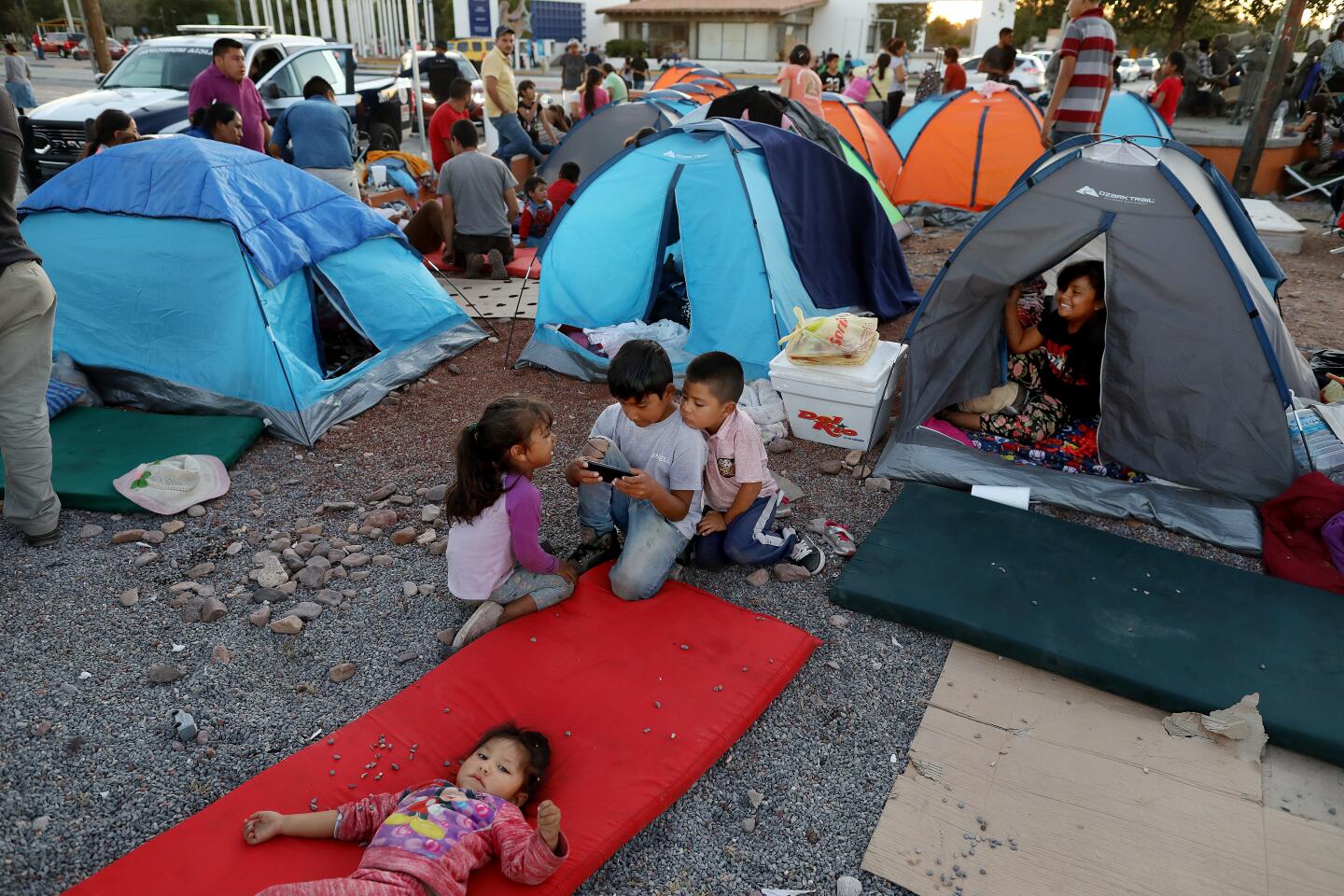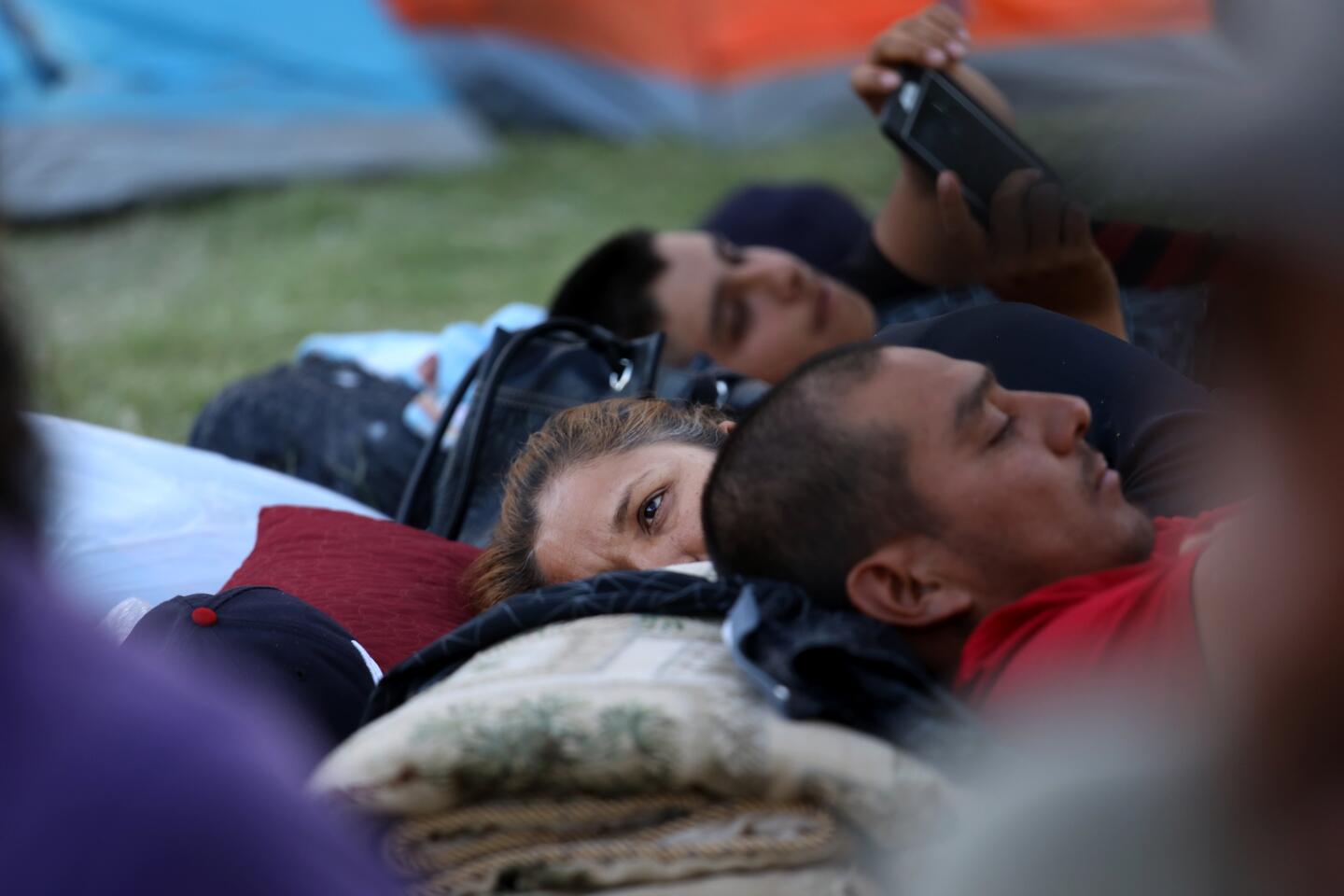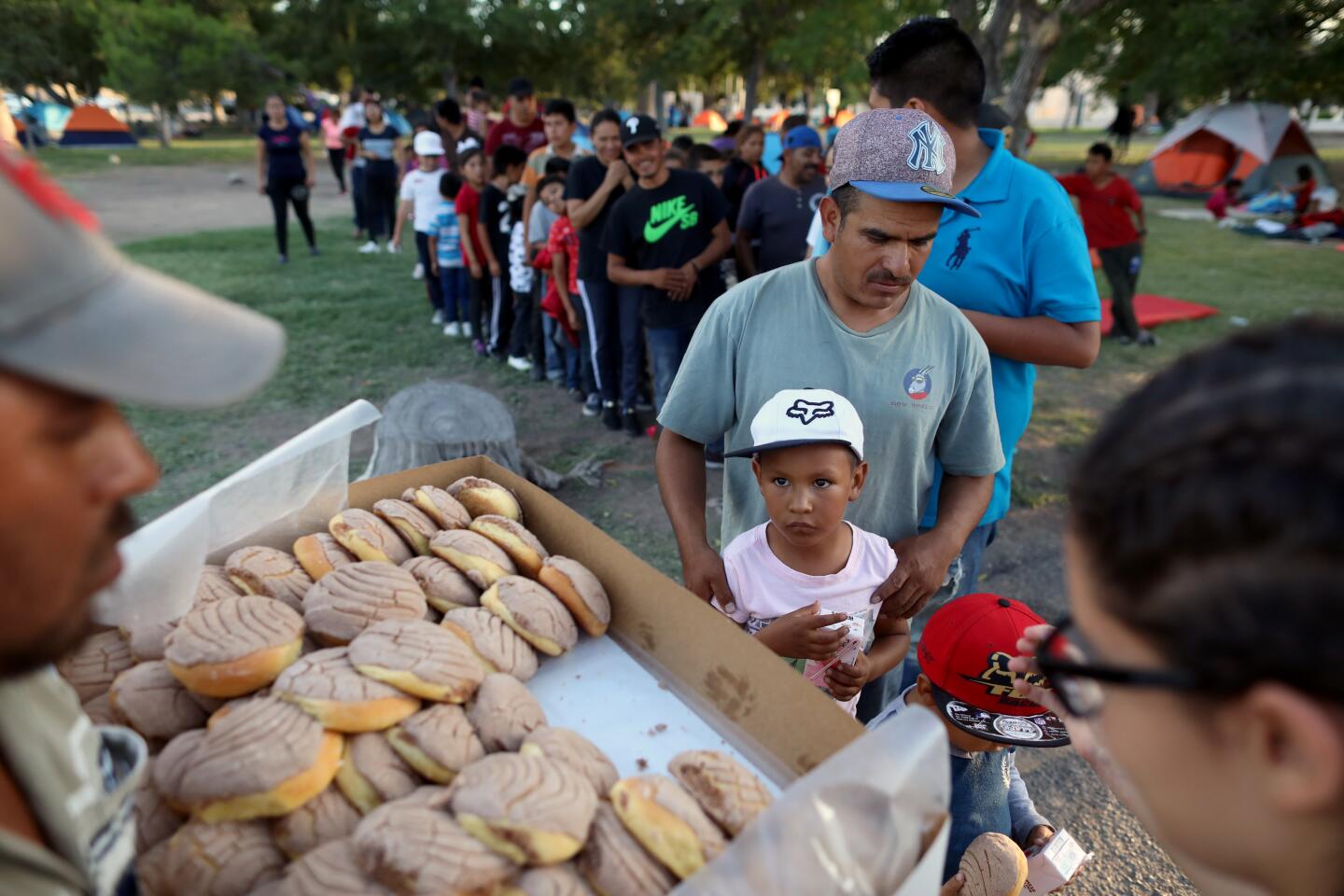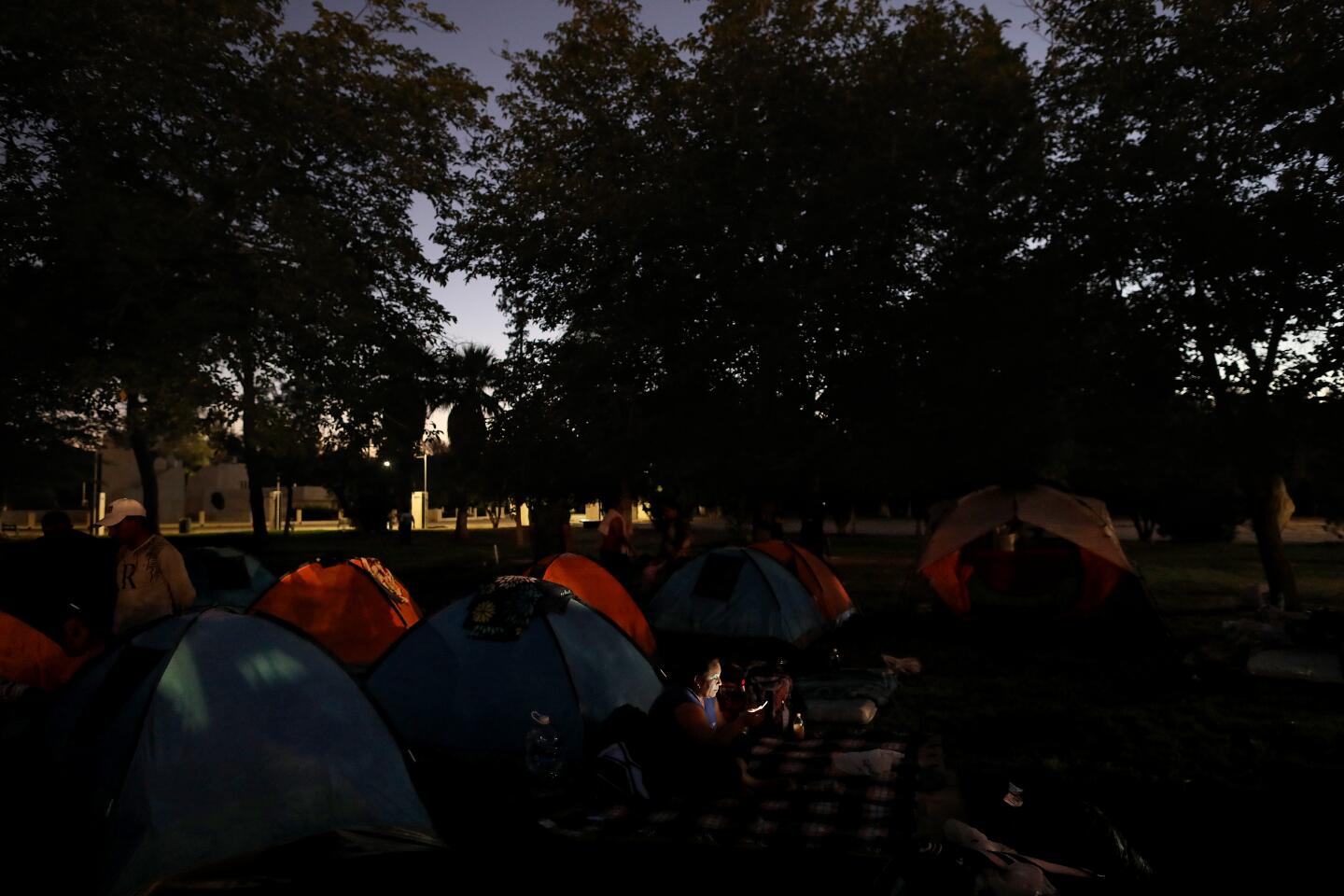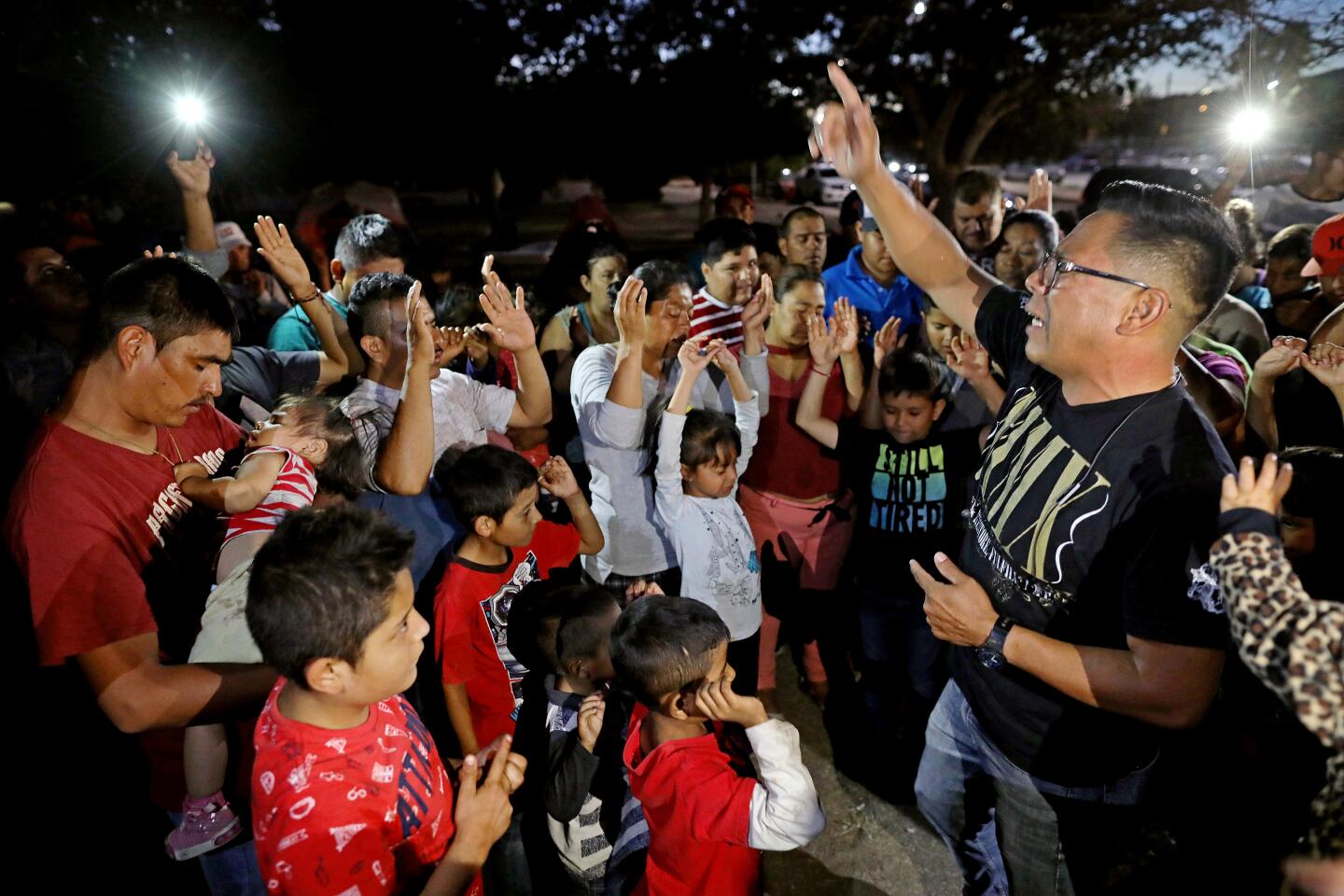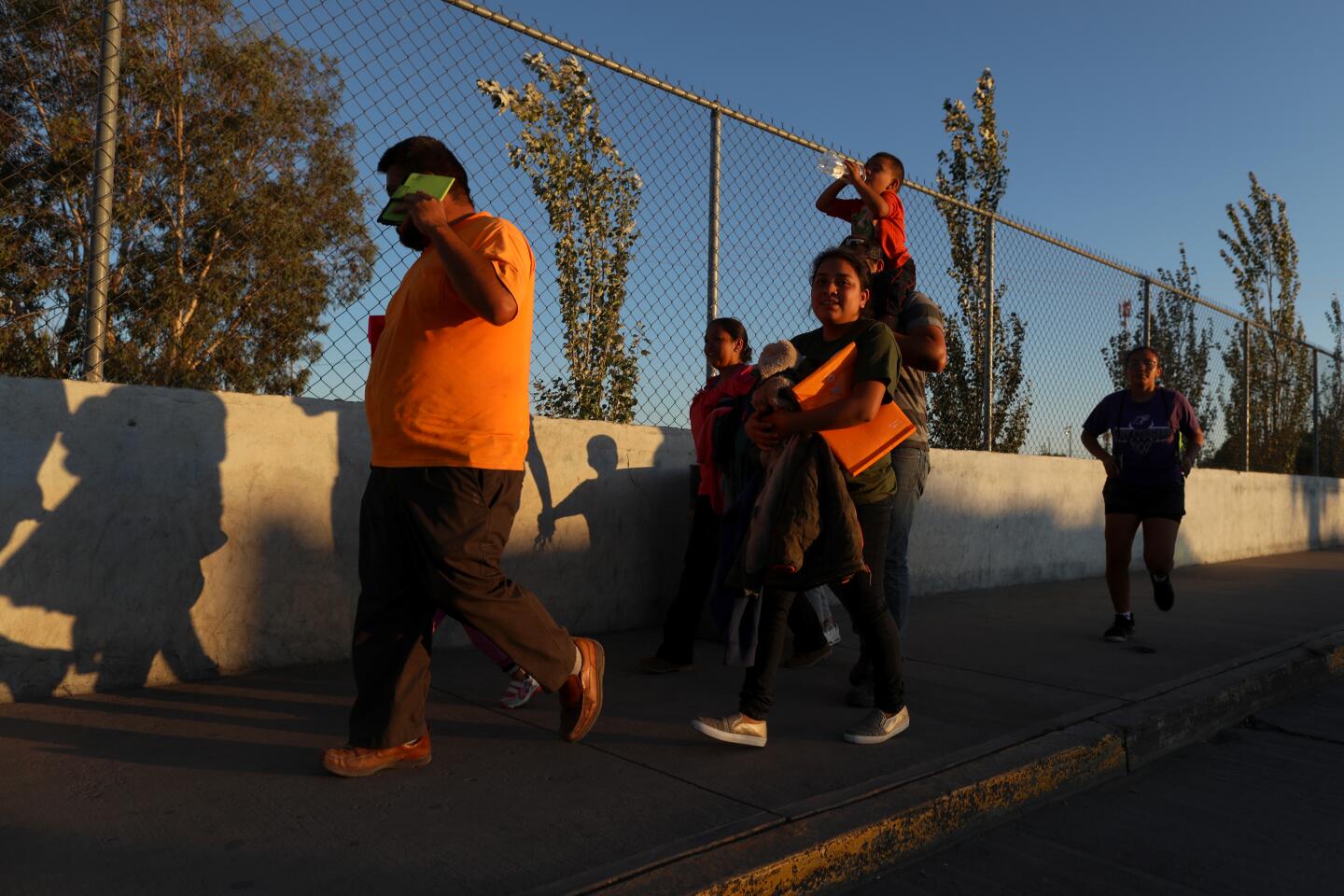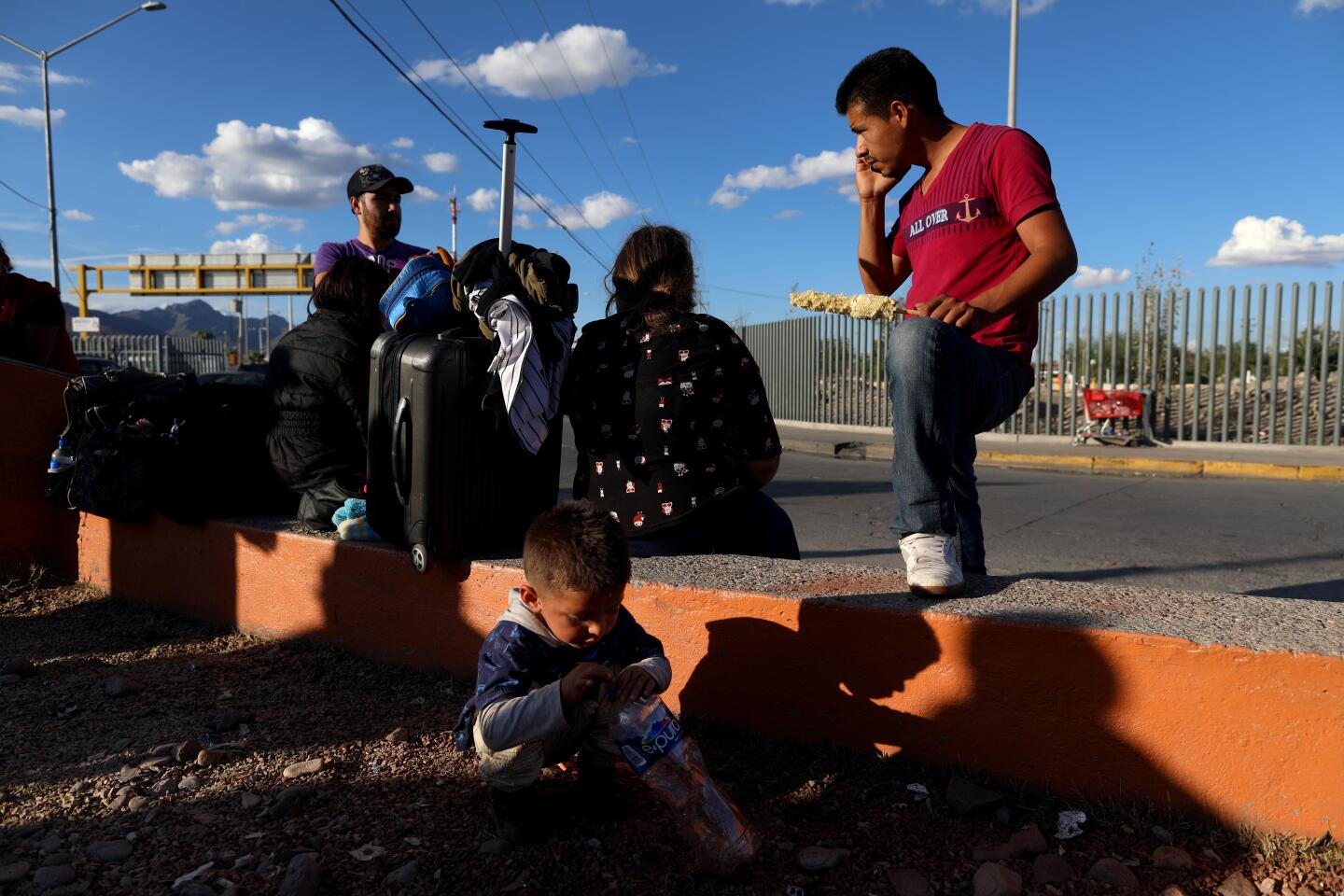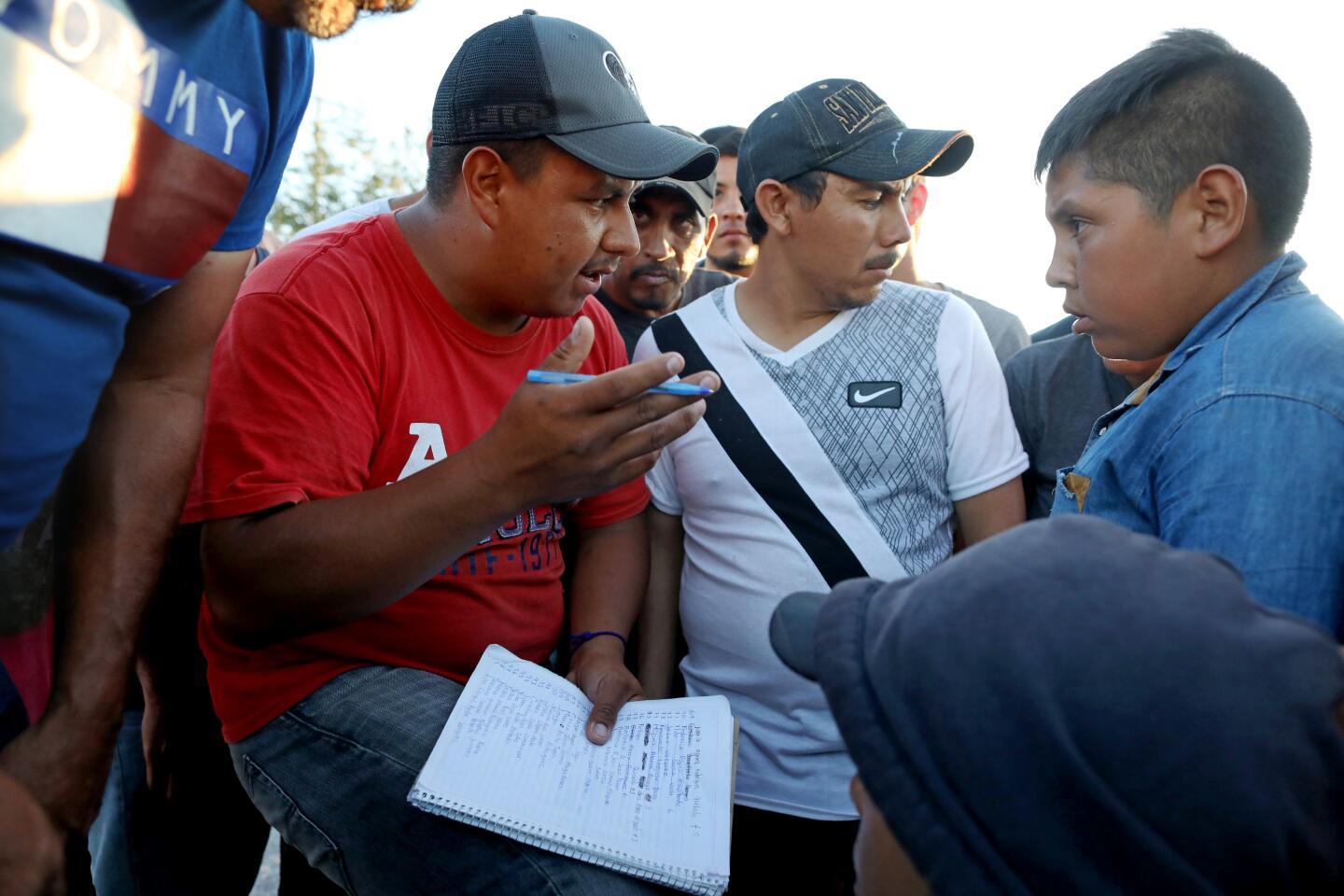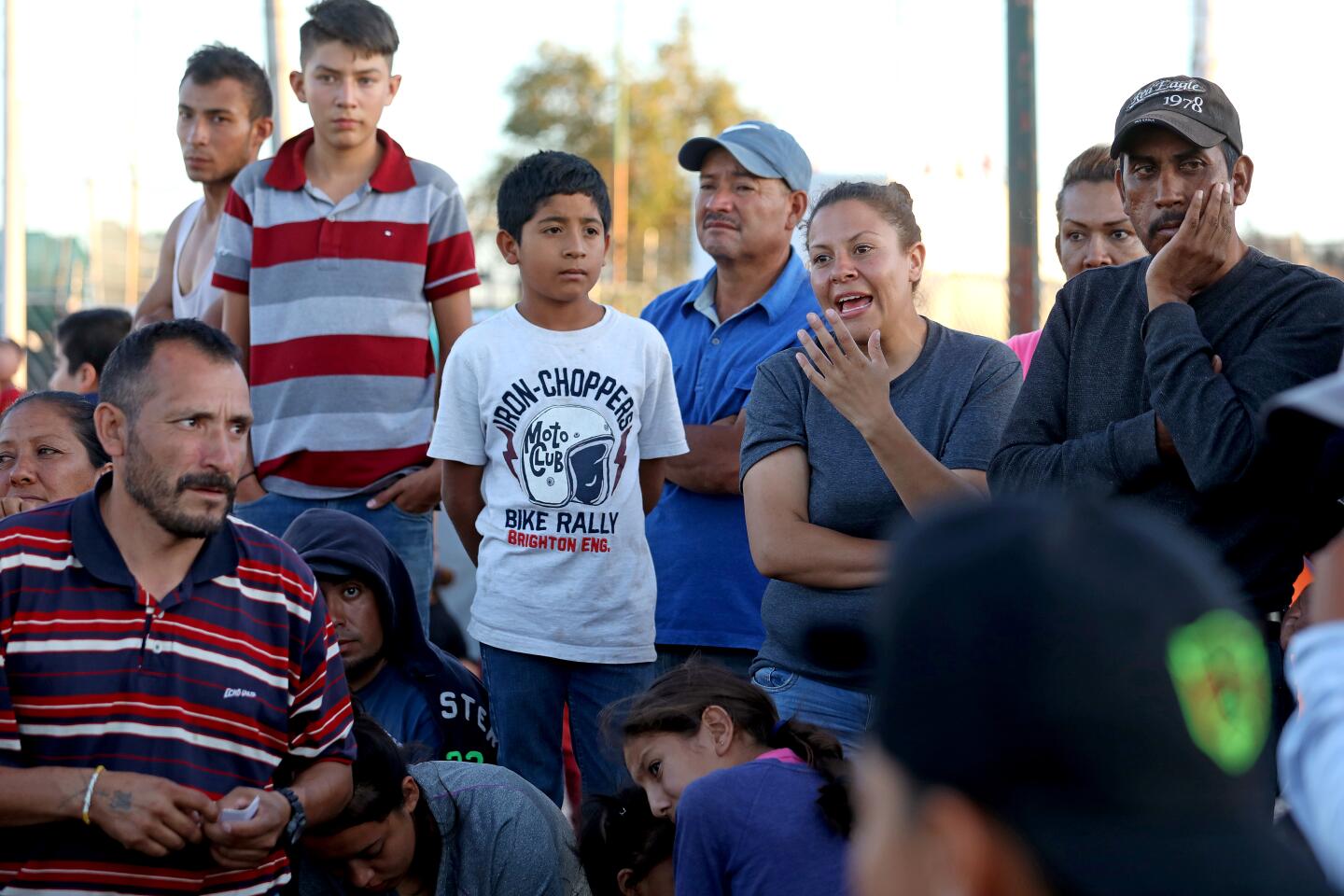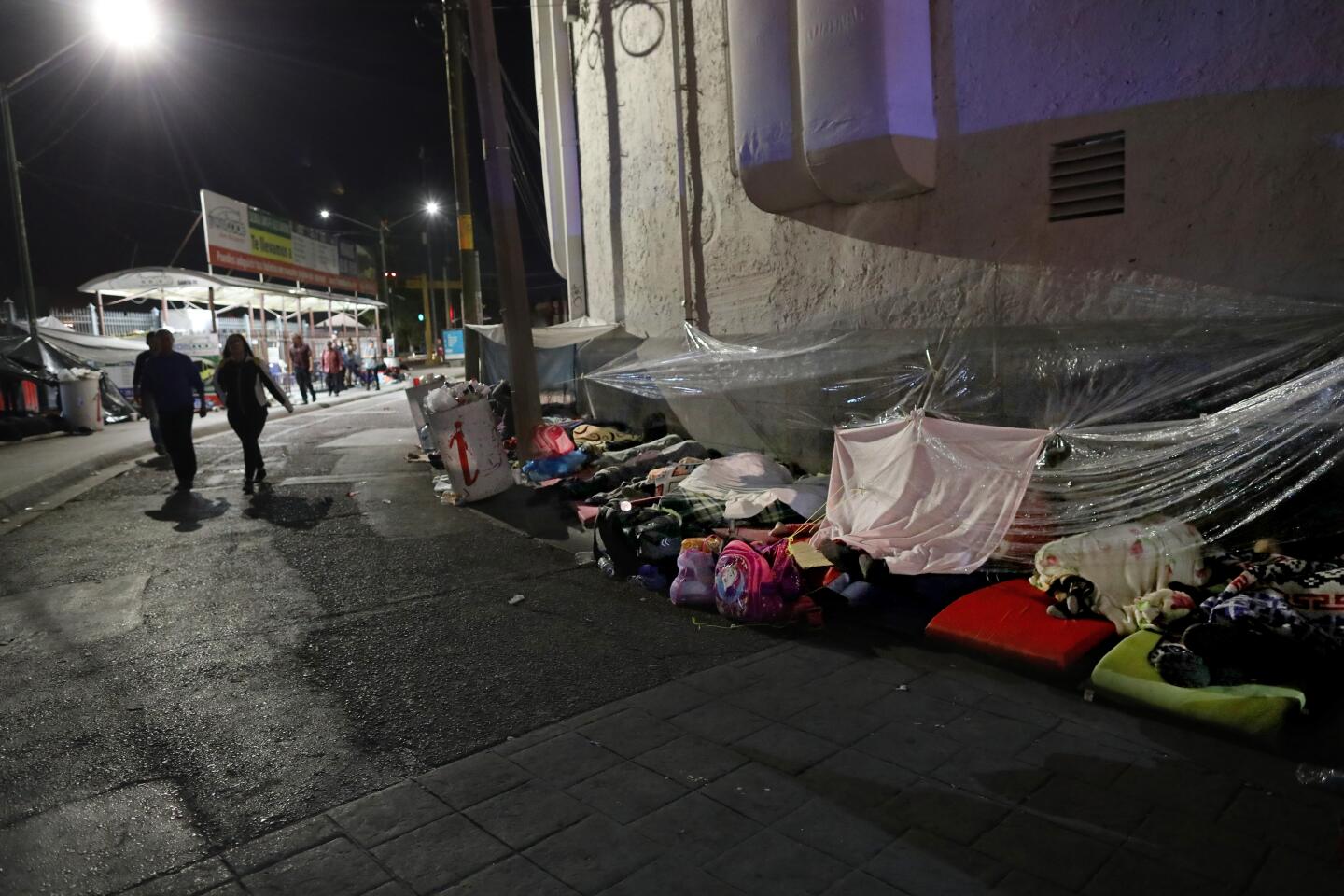Mexican asylum seekers at multiple border crossings grow frustrated with waiting
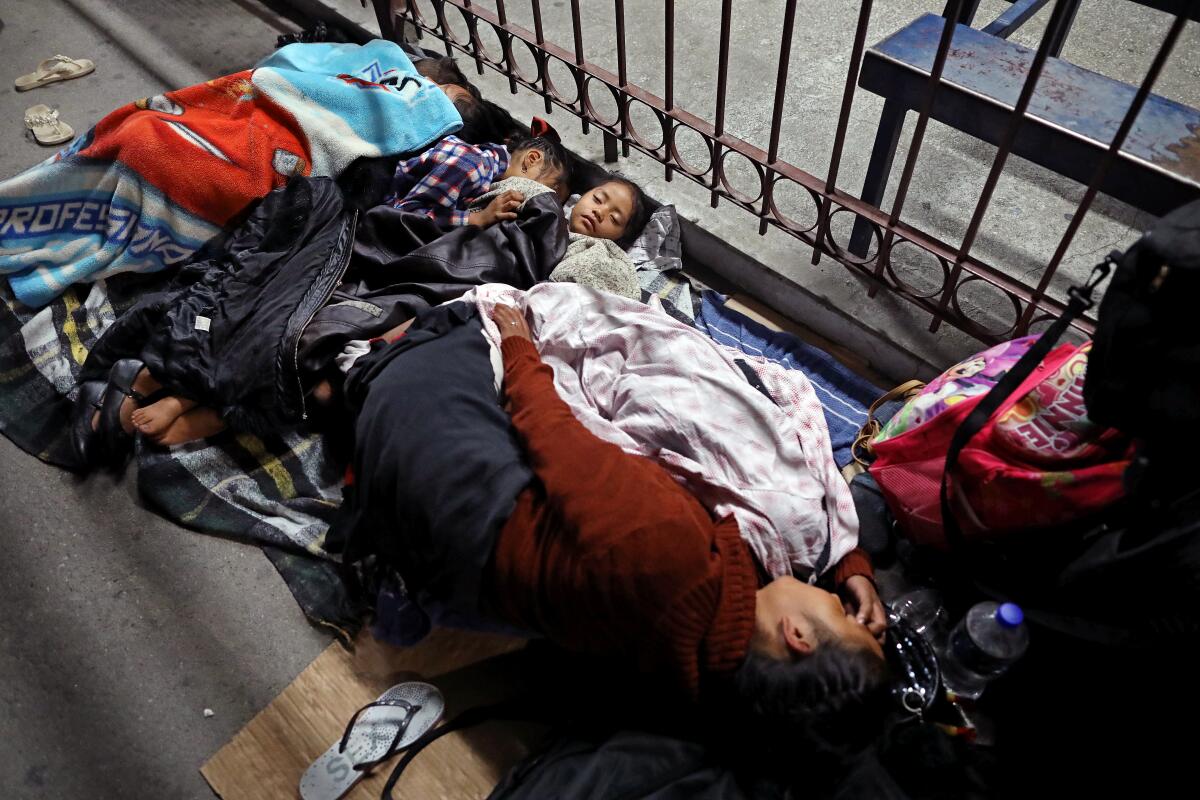
- Share via
CIUDAD JUAREZ, Mexico — Thousands of Mexican migrants seeking asylum in the United States are waiting at border crossings as a result of the Trump administration’s recent crackdown despite concerns for their safety in their home country, migrants and advocates say.
At Ciudad Juarez’s Bridge of the Americas, also known as Puente Libre, dozens of frustrated migrants — some holding newborns — confronted Mexican soldiers last week, challenging a waiting list they worried was keeping them out of the U.S. unfairly.
“We have been here eight days — how much longer?” a woman shouted.
“We all have rights!” a man yelled.
The Trump administration has returned nearly 50,000 migrants from Central America to Mexico under the “Remain in Mexico” program this year, and more recently added an asylum ban for migrants from other countries. Mexican migrants are not subject to the those conditions but nevertheless are finding they may have to wait from days to months for processing in about half a dozen Mexican border cities.
U.S. Customs and Border Protection officials issued a statement Monday saying the agency would process those who are waiting as capacity allows and “as expeditiously as possible.”
“When our ports of entry reach capacity, we have to manage the queues and individuals presenting without documents may need to wait in Mexico as CBP officers work to process those already within our facilities,” the statement said, noting that the facilities at border crossings “were not designed to hold hundreds of people at a time who may be seeking asylum.”
The Homeland Security Department has devoted resources to expanding the Remain in Mexico program and building temporary tent courts. Last year, Customs and Border Protection stationed officers at the midpoints of border bridges to force asylum seekers to wait in Mexico, a process called metering.
Migrants were expected to maintain some of the lists, while others were supervised by Mexican immigration officials who faced allegations of corruption. Late last year, Mexican officials took control of the lists, which have grown to include more than 26,000 people, according to Human Rights Watch.
A spokesman for the American Civil Liberties Union called metering Mexican asylum seekers illegal.
“The practice of metering has no basis in U.S. law,” said Shaw Drake, policy council for the ACLU Border Rights Center in El Paso. “By turning away a Mexican you’re sending them back into the arms of the country they are fleeing.”
Drake said the ACLU was aware of Mexican asylum seekers waiting in Juarez, Matamoros, Nogales and Tijuana. He said Customs and Border Protection was supposed to ensure asylum seekers were processed quickly and not subjected to waiting lists supervised by fellow migrants.
“That entire system of chaos exists because CBP is breaking the law and rejecting people at ports and also refusing to take responsibility for the systems that crop up. It’s been a trend with metering,” Drake said of the migrant waiting lists.
Migrants from Chiapas and Guerrero have been waiting for processing in Matamoros, where volunteers helped at least one Mexican family of three claim asylum Saturday, said local immigration lawyer Jodi Goodwin.
About 300 Mexican asylum seekers were waiting in Nogales on Monday, said Joanna Williams, director of education and advocacy for the Kino Border Initiative. She said Mexican migrants were also having to wait south of Douglas, Ariz.
More than 800 Mexican asylum seekers were waiting south of Yuma, Ariz., as of last week, according to Stephanie Leutert, director of the Mexico Security Initiative at the University of Texas at Austin.
“This is one of the last groups that hasn’t been completely cut off from the U.S. asylum system,” said Leutert, who has been visiting the border to track asylum waiting lists.
Many of the migrants said they were fleeing organized crime. During the first eight months of this year, 23,724 people were slain in Mexico, a 3.5% increase compared with the same period the year before, which was the most violent year since the government started recording statistics in 1997. Some of the states that asylum seekers were fleeing — Guerrero, Michoacan and Zacatecas — were among those with the highest per-capita homicide rates last year.
The recent increase in Mexican migrants may be because of a recent uptick in violence between drug-trafficking gangs in places like Michoacan, Leutert said, but it could also be because the U.S. has blocked asylum seekers from other countries, creating fear among Mexicans.
“You are creating an incentive that says go now before they close that last door on you,” Leutert said.
In Tijuana on Monday, Mexican migrants who had been waiting for months to cross gathered at a border bridge to hear names read from the waiting list of those who would be allowed to cross and seek asylum from U.S. officials. A volunteer reading names from the list — which included about 11,000 individuals — said the majority of those waiting were Mexican.
Fisherman Javier Contreras fled Michoacan with his family by bus two months ago after two of his young children were kidnapped by a cartel and he had to pay a ransom. Contreras, 40, said they came to Tijuana because it was the first bus they could catch, but he did not feel safe even bringing his family to check the list.
“We are running from a life-or-death situation,” he said.
He was number 3,763. On Monday, the list reached 3,055 — Contreras and his family would have to keep waiting. A couple from Chiapas with a 13-year-old son who is a U.S. citizen had been waiting for a month to cross.
After the names were announced, Veronica Narcizo Cisneros started crying. She too would have to keep waiting with her 6-year-old son. Narcizo Cisneros, 23, said she left Guerrero after she was raped a month ago by three masked men who broke into her house. She reported the rape to police but said they did nothing, and she feared her attackers would return.
“I know they could kill me and kill my son,” she said, crying.
In Juarez, at least 1,000 Mexican migrants were camped at three border bridges last week, according to a briefing by the State Population Council. Migrants advocates and shelter managers put the number even higher, between 1,700 and 3,000 waiting to cross. Mexicans recently became the second-highest nationality seeking asylum in Juarez after Cubans, according to the Chihuahua Population Council.
At Puente Libre, the waiting list was written in ink in a blue spiral notebook, managed by the next migrants slated to cross. Pregnant women, families with young or disabled children, and LGBTQ migrants were not given priority. After some names were suspiciously crossed off in pencil last Wednesday, migrants complained to soldiers guarding the bridge. The soldiers, alarmed by the increasingly irate crowd, said the list was not their responsibility.
“If you cause problems, they are going to close the bridge!” one soldier shouted. “Organize yourselves!”
Some of the Mexican migrants were staying at Juarez shelters, but hundreds more were camped in the streets near the Paso del Norte, Ysleta-Zaragoza and Americas bridges, as well as a nearby park, worried that if they left they would miss their chance to cross when their names were called from the list. Many had relatives they hoped to join in the U.S. and said they came to Juarez because it was the shortest route to the border.
Migrant Jose Sepulveda, 23, fled rural Michoacan after he said he was stabbed by drug traffickers who forced his family from their home. His forehead and chest was still scarred from the attack. The farmworker arrived in Juarez on Sept. 19 with his wife and parents and has been sleeping beside a busy street leading to the Paso del Norte bridge. Mexican officials have not provided food, water or shelter — local businesses charge migrants five pesos, or about a quarter, to use the bathroom. Sepulveda’s family was 39 on a list of 96, and only a few were allowed to cross daily. He had hoped to join his sister, a legal resident, in Chicago.
He asked Mexican immigration officials why his family was not allowed to cross, and was told U.S. officials didn’t have enough space for them.
“We can’t ever go back,” Sepulveda said as he sat on a cot that donors had brought the family.
At Puente Libre, the waiting list increased to more than 400 last week and those waiting camped in a nearby park. At least seven women waiting to cross were pregnant; some had newborns, including a 22-day-old baby.
Yenifer Gonzalez Salazar, 22, was four months pregnant. She had fled Zacatecas the week before with her husband, Oswaldo, and 2-year-old son, Tadeo, after relatives were almost kidnapped by a drug gang. Her husband has cousins in Houston and uncles in Fort Worth and Maryland. They were number 298 on the list maintained by fellow migrants.
“We asked if we could go ahead because we are more vulnerable, but they said no because there are people who have been here longer,” she said as she sat outside her tent.
Gonzalez Salazar will wait as long as it takes, she said: “Everyone has to take that risk, to claim asylum.”
Times staff writer Hennessy-Fiske reported from Juarez and San Diego Union-Tribune staff writer Fry from Tijuana.
More to Read
Sign up for Essential California
The most important California stories and recommendations in your inbox every morning.
You may occasionally receive promotional content from the Los Angeles Times.
